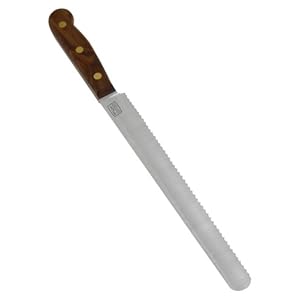Chef's knives are also called French knives or kitchen knives. It kind of depends to whom you're talking. No matter what the name, it's the same knife. Most chef knives are either 6 or 8 inches from the tip of the blade to the end of the handle, but they can be as long as 12 inches. Chef knives are the one knife you absolutely, positively need. If you can't get any other knife, go get one of these. You'll use them to chop vegetables, mince herbs, and slice meat. They can also be used for virtually any other purpose, even if I mention it as a specialty knife later. Above this entry are three different types of chef knives. The top one has a typical blade which is either French or German depending on where the chef that names it is from. The others have Asian blades. Specifically, the bottom is a Santoku blade, which I already mentioned. I recommend a French or German-shaped blade. They allow the blade to rock while you cut. Remember when I mentioned that you should leave the tip of your knife on the cutting board when you cut? That shape of knife will make it easier.
 Boning knives are, surprise surprise, for taking the bones out of meat. They've got longer, flexible blades that curve nicely at the tip. These blades allow you to get right up to the bone and cut right along it, pulling the meat off neatly. However, because it's used less, mine stays sharper longer, so I also use it for the slicing tasks that require an ultra sharp blade, such as slicing tomatoes. These aren't really that necessary, if you're not going to be deboning many different things. You can do that with a chef knife too, but it won't be as clean. Similar to this, but slightly different is the filet knife which is specifically for fish. I have less use for a filet knife than a boning knife; you probably will too.
Boning knives are, surprise surprise, for taking the bones out of meat. They've got longer, flexible blades that curve nicely at the tip. These blades allow you to get right up to the bone and cut right along it, pulling the meat off neatly. However, because it's used less, mine stays sharper longer, so I also use it for the slicing tasks that require an ultra sharp blade, such as slicing tomatoes. These aren't really that necessary, if you're not going to be deboning many different things. You can do that with a chef knife too, but it won't be as clean. Similar to this, but slightly different is the filet knife which is specifically for fish. I have less use for a filet knife than a boning knife; you probably will too. Welcome to the serrated knife in my kitchen. Bread knives are always serrated because they need their teeth to break through the crust of bread. There is no substitute for a good bread knife, because your chef knife will just crush your bread. However, if you're not baking bread (shame on you!), you really don't need one of these until you are.
Welcome to the serrated knife in my kitchen. Bread knives are always serrated because they need their teeth to break through the crust of bread. There is no substitute for a good bread knife, because your chef knife will just crush your bread. However, if you're not baking bread (shame on you!), you really don't need one of these until you are.The best thing about these types of knives is that, many times you can find them all in a good knife set. However, good knife sets are hard to come by, and even harder to buy on a budget. The ones that come with a knife block are the best because you don't have to worry about where you're going to store them all. On the other side, I see chefs knives by themselves in almost every grocery store I visit. Heck, I saw one for $25 in a restaurant supply store today. Make sure the knife is comfortable in your hand and isn't so light it'll fly around the kitchen if you let it go by accident.

No comments:
Post a Comment